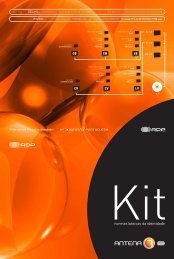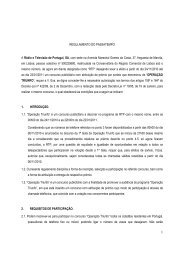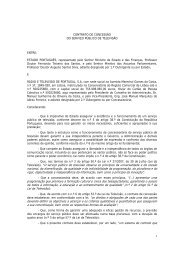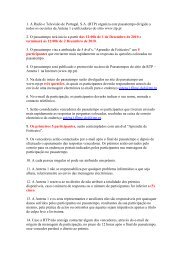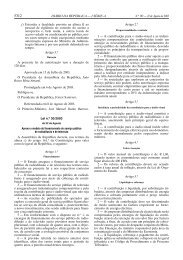6 Bases during the Cold War
6 Bases during the Cold War
6 Bases during the Cold War
Create successful ePaper yourself
Turn your PDF publications into a flip-book with our unique Google optimized e-Paper software.
Access for Soviet surface ships.PeruCalleoOccasional ship visits since Soviet–Peruvian armsdeal.RomaniaMangaliaReported Soviet submarine base on Black Sea.SulinaForward supply base for Soviet Danube flotilla.Source: Compiled from SIPRI data.İ 2007 Robert E. HarkavyDahlak Archipelago (Ethiopia) in <strong>the</strong> western Indian Ocean/Horn of Africa area;Luanda (Angola) in <strong>the</strong> South Atlantic; Latakia and Tartus (Syria) in <strong>the</strong> Mediterranean;and Havana, Cienfuegos and Mariel (Cuba) in <strong>the</strong> western North Atlantic.Beyond that, <strong>the</strong> Soviet Navy had acquired degrees of access – secondary bases,minor facilities, port visits etc. – in numerous o<strong>the</strong>r locales (often <strong>the</strong> subject ofdebate over facts and interpretations). These included Cambodia, India, Iraq, Mauritius,<strong>the</strong> Seychelles, Madagascar, Mozambique, Angola, Congo, Sao Tome andPrincipe, Cape Verde, Guinea Bissau, Benin, Guinea, Algeria, Libya, Yugoslavia,Spain (Canary Islands), Nicaragua and Peru. That may not have been a trulyglobal basing structure, but it was something well beyond what would haveaccorded with a strictly defensive, coastal defense navy, or with <strong>the</strong> assumptionsand expectations of a generation earlier.Soviet air bases70Numerically speaking, <strong>the</strong> <strong>Cold</strong> <strong>War</strong> Soviet Air Force was huge, comprising – invarying degrees of readiness – some 4000 combat aircraft. More than half of <strong>the</strong>sewere primarily configured as interceptors, that is, <strong>the</strong>y were for strategic and/ortactical defense; <strong>the</strong> remainder were configured mostly as ground-attack craft. Stillo<strong>the</strong>rs had as <strong>the</strong>ir primary functions reconnaissance and electronic countermeasures;540 and 30 craft, respectively. In its strategic forces, <strong>the</strong> USSR had some165 long-range, 567 medium-range, and 450 short-range bombers, 68 long-rangereconnaissance craft, some 100 ECM machines and (here deficient relative to <strong>the</strong>U.S.) a <strong>the</strong>n growing force of some 50 Bison and Badger tankers.In line with <strong>the</strong> facts of Soviet ground and naval deployments, most permanentexternal deployments of aircraft were in <strong>the</strong> immediately contiguous areas ofEastern Europe within <strong>the</strong> WTO, Mongolia and Afghanistan. O<strong>the</strong>rwise,however, <strong>the</strong> <strong>Cold</strong> <strong>War</strong> years saw <strong>the</strong> Soviet Air Force break out of <strong>the</strong> confinesof Eurasia to establish more or less permanent bases in Vietnam, South Yemen,Angola and Cuba.The USSR had some 2000 tactical aircraft deployed in Eastern Europe. TheMiG-23 Flogger was by far <strong>the</strong> most numerous fighter-interceptor; followed bylate-model MiG-21 Fishbeds and older Su-15 Flagons. O<strong>the</strong>r less numerousfighter-interceptors included <strong>the</strong> Foxbat, Firebar, Fiddler and <strong>the</strong> <strong>the</strong>n new MiG-31 Foxhound and MiG-29 Fulcrum.Among <strong>the</strong> ground-attack aircraft, <strong>the</strong> most common were <strong>the</strong> Su-17 Fitterand MiG-27 Flogger, though reportedly <strong>the</strong> best interdiction aircraft in <strong>the</strong>Soviet inventory was <strong>the</strong> Su-24 Fencer. O<strong>the</strong>r units were comprised of MiG-23Floggers, <strong>the</strong> <strong>the</strong>n new Su-24 Frogfoot and older MiG-21 Fishbed and Su-7Fitter As. Reconnaissance aircraft deployed in Eastern Europe included MiG-21Fishbeds, Su-17 Fitters, MiG-25 Foxbats and Yak-28 Brewers.In East Germany, <strong>the</strong>re were large numbers of attack and interceptor fighters,a total of 685 combat aircraft, comprising 315 attack aircraft (Su-17s, Su-24s,Su-25s, MiG-27s), 300 fighter interceptors (MiG-21/25/27s), 50 reconnaissancecraft (Su-17s, MiG-25s), plus 20 ECM and 40 light transport aircraft. These134 <strong>Bases</strong> <strong>during</strong> <strong>the</strong> <strong>Cold</strong> <strong>War</strong>İ 2007 Robert E. Harkavywere forward-based at some 17 bases; quantitatively speaking, <strong>the</strong>re were bothmore aircraft and bases than were fielded by <strong>the</strong> U.S. and British counterparts inWest Germany. These were at: Zossen-Wiesdorf, Stralsund, Peenemunde,Parchim (Hind-24 helicopters and long-range transports for troop exchanges),Finow, Werneuchen, Oranienburg, Wittstock, Neuruppin, Zerbst (MiG-25reconnaissance aircraft), Juterborg, Ko<strong>the</strong>n, Welzow, Finsterwalde (Su-20 FitterB fighter regiment), Merseburg, Grossenhein and Alternburg.Page 41Page 42



